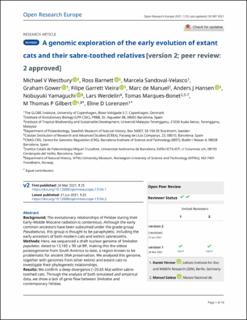A genomic exploration of the early evolution of extant cats and their sabre-toothed relatives
Westbury, Michael V; Barnett, Ross; Sandoval-Velasco, Marcela; Gower, Graham; Vieira, Filipe G.; de Manuel, Marc; Hansen, Anders J.; Yamaguchi, Nobuyuki; Werdelin, Lars; Marquès-Bonet, Tomás; Gilbert, Marcus Thomas Pius; Lorenzen, Eline D.
Peer reviewed, Journal article
Published version

Åpne
Permanent lenke
https://hdl.handle.net/11250/2977177Utgivelsesdato
2021Metadata
Vis full innførselSamlinger
- Institutt for naturhistorie [1225]
- Publikasjoner fra CRIStin - NTNU [38127]
Sammendrag
Background: The evolutionary relationships of Felidae during their Early–Middle Miocene radiation is contentious. Although the early common ancestors have been subsumed under the grade-group Pseudaelurus, this group is thought to be paraphyletic, including the early ancestors of both modern cats and extinct sabretooths.
Methods: Here, we sequenced a draft nuclear genome of Smilodon populator, dated to 13,182 ± 90 cal BP, making this the oldest palaeogenome from South America to date, a region known to be problematic for ancient DNA preservation. We analysed this genome, together with genomes from other extinct and extant cats to investigate their phylogenetic relationships.
Results: We confirm a deep divergence (~20.65 Ma) within sabre-toothed cats. Through the analysis of both simulated and empirical data, we show a lack of gene flow between Smilodon and contemporary Felidae.
Conclusions: Given that some species traditionally assigned to Pseudaelurus originated in the Early Miocene ~20 Ma, this indicates that some species of Pseudaelurus may be younger than the lineages they purportedly gave rise to, further supporting the hypothesis that Pseudaelurus was paraphyletic.
